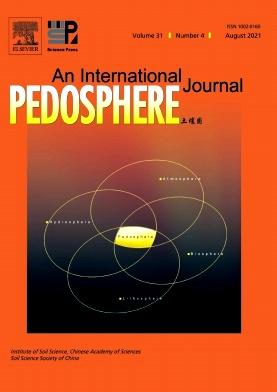控制甘薯上土传病原体 Ceratocystis fimbriata 的方法:微型综述
IF 7.3
2区 农林科学
Q1 SOIL SCIENCE
引用次数: 0
摘要
丝状角鼻虫是一种危险的真菌病原体,可引起甘薯根部的黑腐病,导致甘薯生长和储存期间的毁灭性损失。本文首次综述了合成杀菌剂、生物防治剂、涂料和天然化合物等防治甘薯毛霉的方法。讨论了不同方法的优缺点,并对其效果进行了比较。芽孢杆菌菌株和合成杀菌剂多菌灵、氟triafol、立果灵、Stadium®、噻苯达唑和甲基硫代盐的抑制效果最强。由于合成杀菌剂对人体健康的有害影响,芽孢杆菌菌株比合成杀菌剂具有优势。丝状真菌和酵母作为生物防治剂在毛菌管理中的应用尚未进行研究。涂层表现出有限的保护作用,并且没有尝试将涂层与纳米颗粒或精油结合起来。虽然紫苏醛和橙花醇是廉价无毒的天然化合物,但它们的功效较低。所有的管理策略都用于采收后的甘薯根和叶。然而,在植物生长过程中,尚无有效的方法来控制植物根系中的毛霉。尽管近年来已经报道了几种控制甘薯上的红弧菌的方法,但许多知识空白阻碍了有效和安全方法的发展。本文章由计算机程序翻译,如有差异,请以英文原文为准。
Methods for control of soil-borne pathogen Ceratocystis fimbriata on sweet potato: A mini review
Ceratocystis fimbriata is a hazardous fungal pathogen that causes black rot disease in sweet potato roots, leading to devastating losses during sweet potato growth and storage. All methods for managing C. fimbriata on sweet potato based on synthetic fungicides, biocontrol agents, coatings, and natural compounds are reviewed for the first time. The advantages and disadvantages of the different methods are discussed, and their efficacies are compared. Bacillus strains and the synthetic fungicides carbendazim, flutriafol, liguoling, Stadium®, thiabendazole, and thiophanate methyl show the strongest inhibitory effects. Bacillus strains possess an advantage over synthetic fungicides due to the detrimental impact of the latter on human health. The application of filamentous fungi and yeasts as biocontrol agents for C. fimbriata management has not yet been investigated. Coatings exhibit limited protection, and no attempts have been made to combine coatings with nanoparticles or essential oils. Although the natural compounds perillaldehyde and nerol are inexpensive and non-toxic, they are of low efficacy. All management strategies have been used on postharvest sweet potato roots and leaves. However, there is no approach to controlling C. fimbriata in roots during plant growth. Even though several methods for controlling C. fimbriata on sweet potato have been reported in recent years, numerous knowledge gaps impede the development of effective and safe approaches.
求助全文
通过发布文献求助,成功后即可免费获取论文全文。
去求助
来源期刊

Pedosphere
环境科学-土壤科学
CiteScore
11.70
自引率
1.80%
发文量
147
审稿时长
5.0 months
期刊介绍:
PEDOSPHERE—a peer-reviewed international journal published bimonthly in English—welcomes submissions from scientists around the world under a broad scope of topics relevant to timely, high quality original research findings, especially up-to-date achievements and advances in the entire field of soil science studies dealing with environmental science, ecology, agriculture, bioscience, geoscience, forestry, etc. It publishes mainly original research articles as well as some reviews, mini reviews, short communications and special issues.
 求助内容:
求助内容: 应助结果提醒方式:
应助结果提醒方式:


